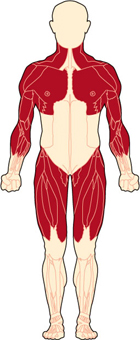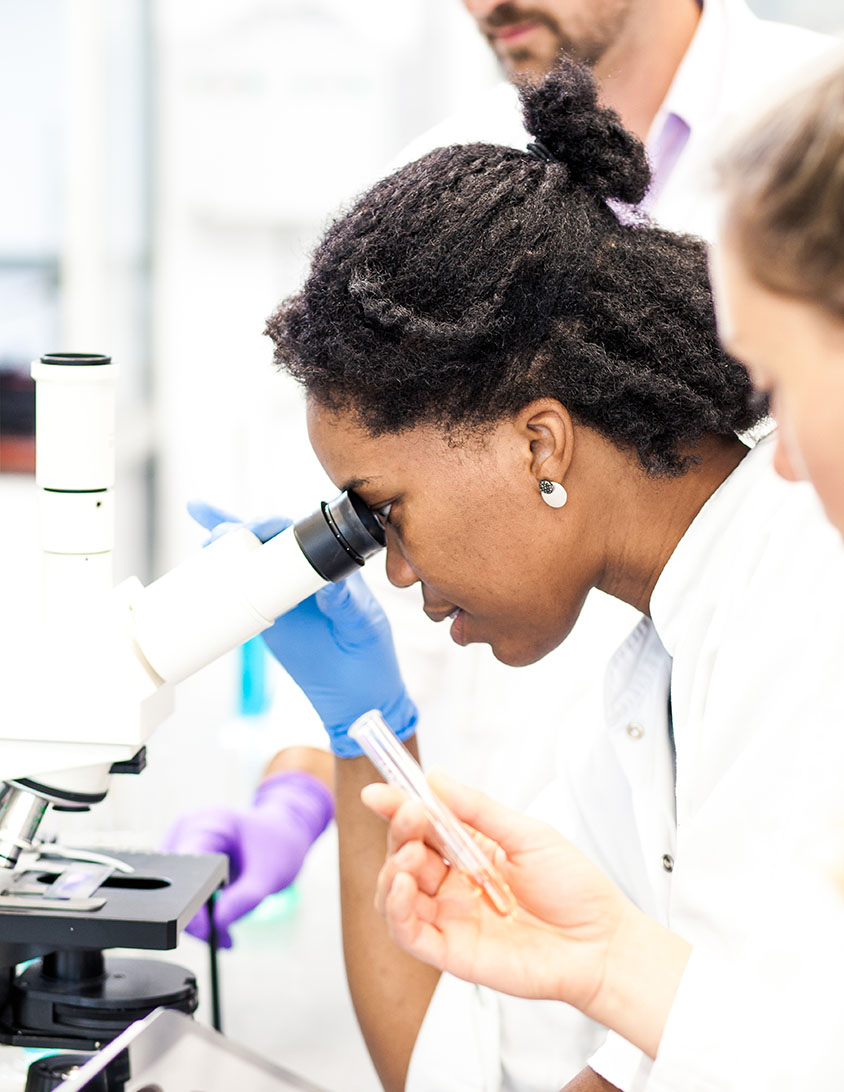Duchenne Muscular Dystrophy (DMD)
Duchenne Muscular Dystrophy (DMD)
Table of Contents
- What is Duchenne muscular dystrophy (DMD)?
- What are the symptoms of DMD?
- What causes DMD?
- What are DMD “carriers”?
- What is the life expectancy in DMD?
- What treatments are available for DMD?
- What is the status of DMD research?
- Additional Reading
- Additional Links
What is Duchenne muscular dystrophy?
In the early stages, DMD affects the shoulder and upper arm muscles and the muscles of the hips and thighs. These weaknesses lead to difficulty in rising from the floor, climbing stairs, maintaining balance and raising the arms.
Duchenne muscular dystrophy (DMD) is a progressive, genetic (X-linked recessive) neuromuscular disorder caused by mutations to the DMD gene, resulting in the dysfunction or absence of the dystrophin protein. When functional, dystrophin helps keep muscle cells intact, and without dystrophin, muscle cells are vulnerable to injury, resulting in progressive muscle degeneration and weakness. DMD is one of four conditions known as dystrophinopathies. The other three diseases that belong to this group are Becker muscular dystrophy (BMD, a milder condition than DMD); an intermediate clinical presentation between DMD and BMD; and DMD-associated dilated cardiomyopathy (heart-disease) with little or no clinical skeletal, or voluntary, muscle disease.
DMD symptom onset is in early childhood, usually between ages 2 and 3. The disease primarily affects males, though females can be symptomatic carriers, or in rare cases can be severely affected.
DMD occurs in approximately 1 in 3,500 to 5,000 male births.
What are the symptoms of DMD?
Muscle weakness is the principal symptom of DMD. It can begin as early as age 2 or 3, first affecting the proximal muscles (those close to the torso) and later affecting the distal limb muscles (those close to the extremities). Usually, the muscles of the lower body are affected before the muscles of the upper body. Affected children may have difficulty jumping, running, and walking. Other symptoms include calf enlargement, toe walking or a waddling gait, and lumbar lordosis (an inward curve of the spine). Over time, muscles that help with breathing and the heart can also become weaker, which can lead to more serious health problems. By adolescence, most boys with DMD require the use of ambulatory assistive devices, such as wheelchairs. With better medical care, many people with DMD are now living longer and more active lives than in the past. For more about DMD symptoms, see Signs and Symptoms.
Becker muscular dystrophy (BMD) is similar to DMD, but with onset usually in the teens or early adulthood. The disease course for BMD is slower and less predictable compared to DMD.
What causes DMD?
DMD was first described by the French neurologist Guillaume Benjamin Amand Duchenne in the 1860s, but until the 1980s when specific genes were discovered, little was known about the cause of any kind of muscular dystrophy. In 1986, MDA-supported researchers identified a particular gene (DMD) on the X chromosome that, when mutated, caused DMD. In 1987, the protein associated with the DMD gene was identified and named dystrophin. Dystrophin helps protect muscle cells and keep them strong. When the gene does not work properly, the body cannot make dystrophin, and muscle cells are damaged more easily. Over time, these damaged muscle cells are lost and replaced by scar tissue or fat, which causes the muscles to get weaker. Since the original discovery of DMD, thousands of individual mutations to the DMD gene have been identified as a cause for DMD. Presently, advances in molecular diagnostics now allows for precise mutation identification, which is necessary for mutation specific treatments.
DMD has an X-linked recessive inheritance pattern and is passed on by the mother, who is referred to as a carrier. For more about the way gene mutations cause DMD, see Causes/Inheritance.
What are DMD “carriers”?
Since males only have one X chromosome, they are more likely to be affected. Females can be carriers of the disease, meaning they have one healthy DMD gene and one DMD gene with a mutation. Although most carriers of DMD do not themselves have signs and symptoms of the disease, some do and are often called “manifesting carriers.” Symptoms can range from mild skeletal muscle weakness or cardiac involvement to severe weakness or cardiac effects and can begin in childhood or adulthood. Cardiac monitoring with echocardiograms or cardiac MRIs is recommended for all DMD carriers beginning in adolescence and repeated every 3-5 years. For more, read Females and DMD in Causes/Inheritance.
What is the life expectancy in DMD?
Until the 2000s, boys with DMD usually did not survive much beyond their teen years. Because of improved guidelines recommending comprehensive multidisciplinary care, standardization of corticosteroid treatments, disease-modifying treatments, and advances in cardiac and respiratory support, life expectancy is increasing and many young adults with DMD attend college, have careers, get married, and even have children. Survival into the early 30s, and even 40s, is becoming more common than before.
What treatments are available for DMD?
Current management of DMD includes both supportive and targeted disease modifying therapeutics. Supportive care is available through multidisciplinary clinics with neurologists, cardiologists, pulmonologists, endocrinologists, physical and occupational therapists, and nutritionists. Traditional corticosteroids (i.e., prednisone, deflazacort, and vamoralone) slow the progression of muscle weakness and delay the loss of ambulation (walking ability). Vamoralone, a steroid analogue, was approved by the U.S. Food and Drug Administration (FDA) in 2023 to offer the benefits of traditional steroids with fewer side effects. Exon skipping drugs (eteplirsen, golodirsen, viltolarsen, and casimersen) target specific mutations, theoretically converting DMD to BMD. Gene therapy (delandistrogene moxeparvovec-rokl) was approved in 2023 by the FDA and delivers a “micro-dystrophin” to muscle cells. Lastly, givinostat, a histone deacetylase inhibitor, was approved by the FDA in 2024 to promote muscle regeneration and reduce inflammation. For more about available treatments for DMD, see Medical Management.
What is the status of DMD research?
MDA-supported researchers are actively pursuing several exciting strategies in DMD and research into DMD continues to grow rapidly. Several of the strategies include next-generation exon skipping therapies, novel anti-inflammatory agents, myostatin inhibition and utrophin upregulation, next-generation micro-dystrophin gene therapy, CRISPR based gene editing, and muscle stem cell therapies. Human clinical trials are underway for some of these strategies. Today, thanks to advances in science and medicine, people with DMD are living longer and with better quality of life than ever before. For an overview of DMD research strategies and the latest research news, see Research.
To learn more about neuromuscular diseases, including DMD, see:
Additional Reading
- Understanding Neuromuscular Disease Care. IQVIA Institute. Parsippany, NJ. (2018).
- Romitti, P. A. et al. Prevalence of Duchenne and Becker Muscular Dystrophies in the United. Pediatrics (2015). doi:10.1542/peds.2014-2044
Additional Links
Community Letter from Sarepta Therapeutics: Update regarding ELEVIDYS
Looking for more information, support, or ways to get involved?
Last reviewed May 2025 by Stephen Chrzanowski M.D., Ph.D.

